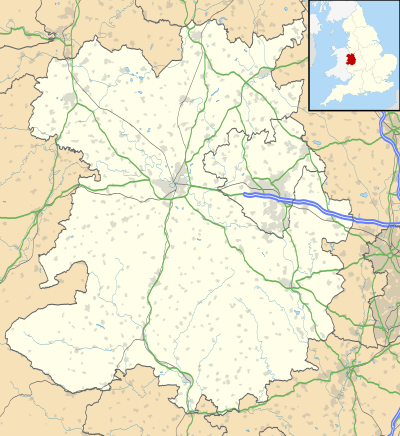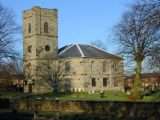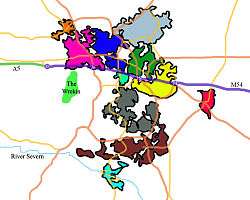Dawley
Dawley is a town in the borough of Telford and Wrekin and ceremonial county of Shropshire, England. Today, it forms part of the new town of Telford, which was originally, in 1963, going to be named 'Dawley New Town' before it was decided in 1968 to name the town 'Telford', after the engineer and road-builder Thomas Telford.
| Dawley | |
|---|---|
.jpg) High Street, Dawley | |
 Dawley Location within Shropshire | |
| Population | 11,399 |
| OS grid reference | SJ686068 |
| Civil parish |
|
| Unitary authority | |
| Ceremonial county | |
| Region | |
| Country | England |
| Sovereign state | United Kingdom |
| Post town | TELFORD |
| Postcode district | TF4 |
| Dialling code | 01952 |
| Police | West Mercia |
| Fire | Shropshire |
| Ambulance | West Midlands |
| UK Parliament | |
Dawley is one of the older settlements in Shropshire, being mentioned in the Domesday Book (1086). It is divided into Dawley Magna ("Great Dawley") and Little Dawley (also shown as Dawley Parva ("Little Dawley") on older maps).
Local government
The town's main civil parish is officially called Great Dawley — its parish council is officially Great Dawley Town Council. Dawley Hamlets is a separate civil parish, which covers Little Dawley and other neighbouring villages/suburbs.
Railways
The nearest railway station is Telford Central. Historically, the Great Western Railway maintained a line that passed through the parish, going through the tunnel at Heath Hill. This tunnel is still used and is currently part of Telford Steam Railway's expansion project. It was also served by the single platformed station at Dawley and Stirchley railway station on the Coalport Branch Line which ran from Hadley to Coalport. It opened in 1860 but closed in 1952 and the trackbed including platform now form part of the Silkin Way.[1]
History
Dawley is mentioned in the Domesday Book and is therefore one of the older settlements in Shropshire.
There was a castle in Dawley, but it was demolished around 1648. The site is unknown, although the Castle Pools (on the old quarry site) and Castle Ironworks (built by the Darby family, one of whom commissioned the world-famous Iron Bridge) possibly indicate the general area where it may have stood. Prior to the landscaping which followed the creation of Telford New Town, extensive ruins were detectable next to the Castle Pools and are shown on old maps as being the location of the castle, but, in the 1980s, the whole area was buried under thick topsoil and planted with trees. Ironbridge is a short distance away.
Dawley was, for over three centuries, a mining town, both for coal and ironstone. Clay extraction, for local industrial-pipe factories, brickyards and the pottery industry, has been a major influence on the landscape. The mining had an important impact on the local culture. In 1821, production at the ironworks of Dawley was halted for a say by striking miners in protest at a lowering of their wages. Many of the workers in Dawley joined the larger group of protesters in what came to be known as the Cinderloo Uprising.[2] In 1872, the Springwell Pit Disaster resulted in the deaths of eight men and boys.
Prior to large-scale levelling as part of the development of Telford New Town, the area was covered by clay mounds and large clay pits that dominated the landscape, to the extent that they formed points of reference for the locals. There is still a local clay-pipe factory in the adjacent Doseley village; grey clay predominates on the immediate outskirts of Dawley.
The adjacent village of Horsehay was the site of a bridge and later a crane fabrication factory that exported around the world. The bridge over Victoria Falls is said to have been built there. Telford Steam Railway trust is located across the road from the former factory site.
On Monday, 7 June 2010, Dawley had become subject to a lot of media attention because some locals had recreated the 'Hollywood' sign on a noticeable bank on Paddock Mount but with Dawley instead of Hollywood. The Shropshire Star had a full-page spread article on that day's evening edition to honour the effort made by the locals. As of midday on Tuesday, 8 June 2010, over 1000 Telfordians had joined a Facebook group showing support for the sign, acknowledging the efforts of its creators, and in protest against the controversial redevelopment of the mount to move the Phoenix Academy (now the Telford Langley School) there.[3]
Dawley is famed for its dialect, which includes some quite unique words, including "bist", presumably from the German meaning "are". However, the dialect is largely lost. Along with the dialect were various conventions and traditions, notably the "pig on the wall". Traditionally, Dawley residents would show their support for The Dawley Prize Band or other civic marches by placing their pigs on their walls. The pig also features in the dialect, with a romantic phrase apparently being "I wudna swop thee for a big black pig!"[4]
Geography
Dawley has a street-market every Friday. Dawley town centre consists of a single pedestrianised street that was previously the main route from Bridgnorth in the south to Wellington in the north. The area around Dawley, not covered by Telford New Town, is rural and provides extensive opportunities for walking. The Ironbridge Gorge and The Wrekin are both pleasant walks from Dawley.
On the northern edge of Dawley is Malinslee where St. Leonards church stands. The design of St. Leonards, a slightly irregular octagon, is said to have been influenced by Thomas Telford. Other churches supposedly influenced by Thomas Telford during his work in Shropshire are at nearby Madeley and Bridgnorth.

Education
There are seven primary schools in the Dawley area, and a comprehensive secondary school, Telford Langley School. There are two special schools in Dawley: the Mount Gilbert and Southall schools.[5]
In July 2012, the Department for Education and Arts Council England selected Telford & Wrekin as one of the new areas for the In Harmony programme, working with Old Park Primary School and Children's Centre, Telford & Wrekin Music, City of Birmingham Symphony Orchestra and the Manchester Camerata. In Harmony is a national programme that aims to inspire and transform the lives of children in deprived communities, using the power and disciplines of community-based orchestral music-making.[6]
Notable people
William 'Billy' Ball (1795–1852), the 'Shropshire Giant', was a nineteenth-century iron puddler and giant.
Samuel Peploe (1667-1752), later Bishop of Chester, was a native of Dawley Parva, where he was baptised.
Joseph Simpson (1909-1968) was born in Dawley, and was the head of the London Metropolitan Police, from 1958 to 1968.
Dawley was the birthplace of Captain Matthew Webb who was the first man to swim the English Channel - his monument stands on the High Street. Legend suggests that a pig stood up against a wall to watch the parade in Webb's honour that was held on his return.[7] Two roads in the town, Captain Webb Drive and Webb Crescent, are named after him, as is the Captain Webb Primary School.
William Foulke, a former England international goalkeeper, was born at Dawley in 1874. Edith Pargeter, who under her pen name of Ellis Peters wrote the Brother Cadfael novels, went to school in Dawley.[8] Numerous roads in Aqueduct, such as Cadfael Drive and Ellis Peters Drive, are 'themed' after her.
Danielle Jones, a fictional character in EastEnders during 2008-09, played by Lauren Crace, came from Dawley.
Dawley received some unwanted media attention in July and August 2011, when the Shropshire Star newspaper revealed that Nicola Holmes, a local councillor currently suspended by the local Labour party, was working as a prostitute - a story which was then picked up by The Sun. Ms. Holmes has since resigned as a councillor.
Former Aston Villa striker Dalian Atkinson was living in Little Dawley at the time of his death in 2016.[9]
See also
- Listed buildings in Great Dawley
- Listed buildings in Dawley Hamlets
- Shropshire Revolution - American Football Team, based in Dawley
References
- "Silkin Way - cycling and walking route". Telford and Wrekin Council. Retrieved 2 April 2019.
- Mercer, A. C. B (January 1966). "Cinderloo Affair". Shropshire Magazine.
- "Local newspaper article about the Hollywood style sign". Shropshire Star. 14 August 2010. Retrieved 4 May 2014.
- "Dawley Dialect". Retrieved 7 November 2011.
- "UK Schools & Colleges Database". Schools Web Directory. Retrieved 16 May 2008.
- "In Harmony". Arts Council. Archived from the original on 26 May 2013. Retrieved 29 May 2013.
- "Captain Matthew Webb". Shropshire Mining. Archived from the original on 30 May 2013. Retrieved 16 May 2008.
- "Edith Pargeter - creator of the crimefighting monk". BBC Shropshire. Retrieved 16 May 2008.
- ""Charismatic Dalian enriched our lives"". Shropshire Star. 21 November 2016. p. 4.Report by Lisa O'Brien, published following his funeral.
External links
| Wikimedia Commons has media related to Dawley. |
